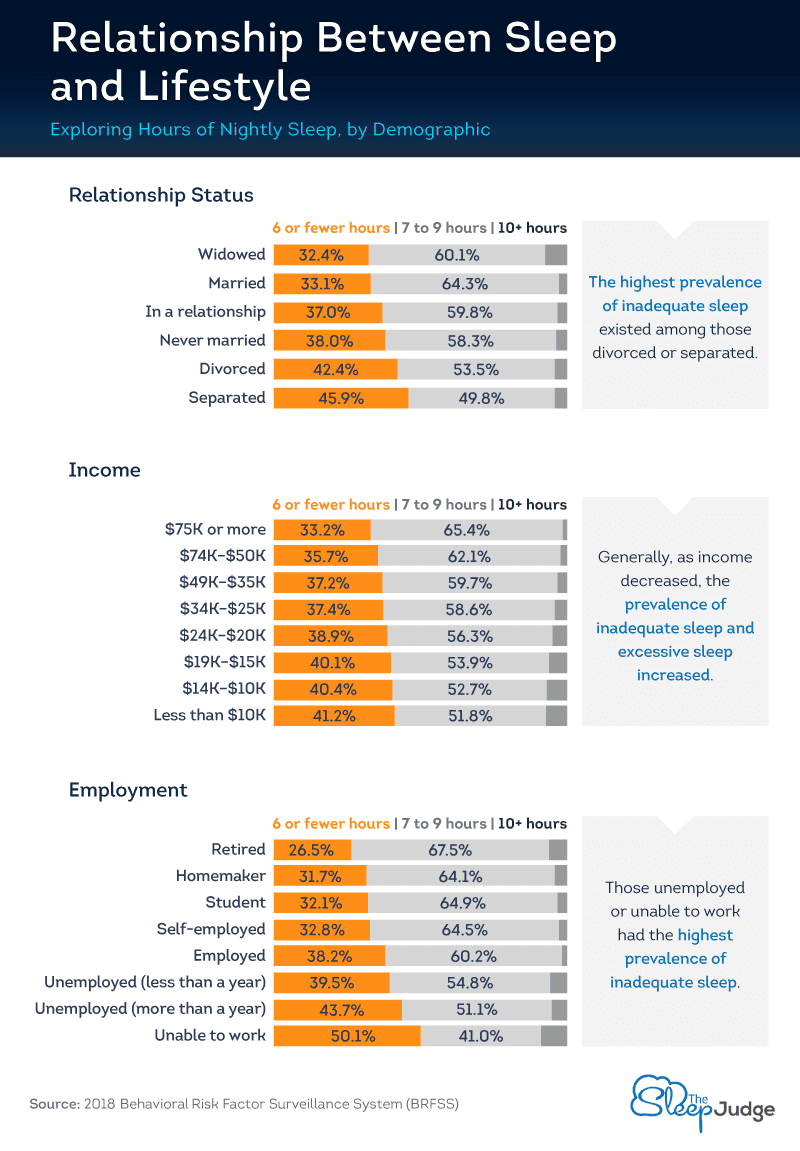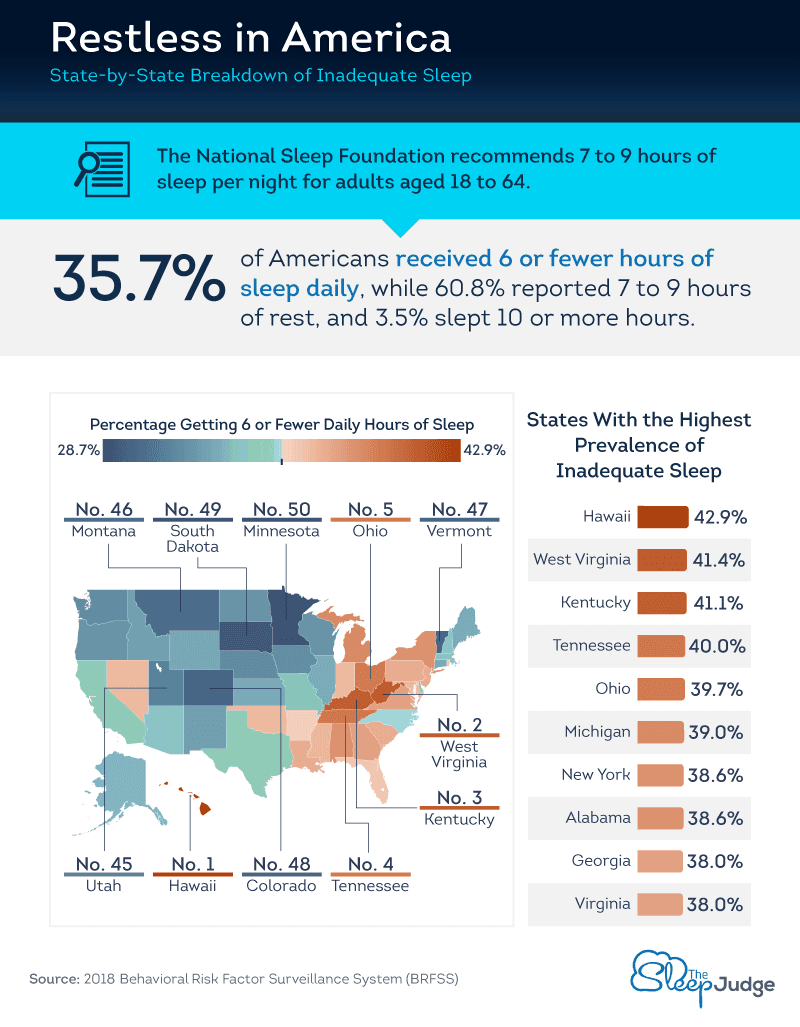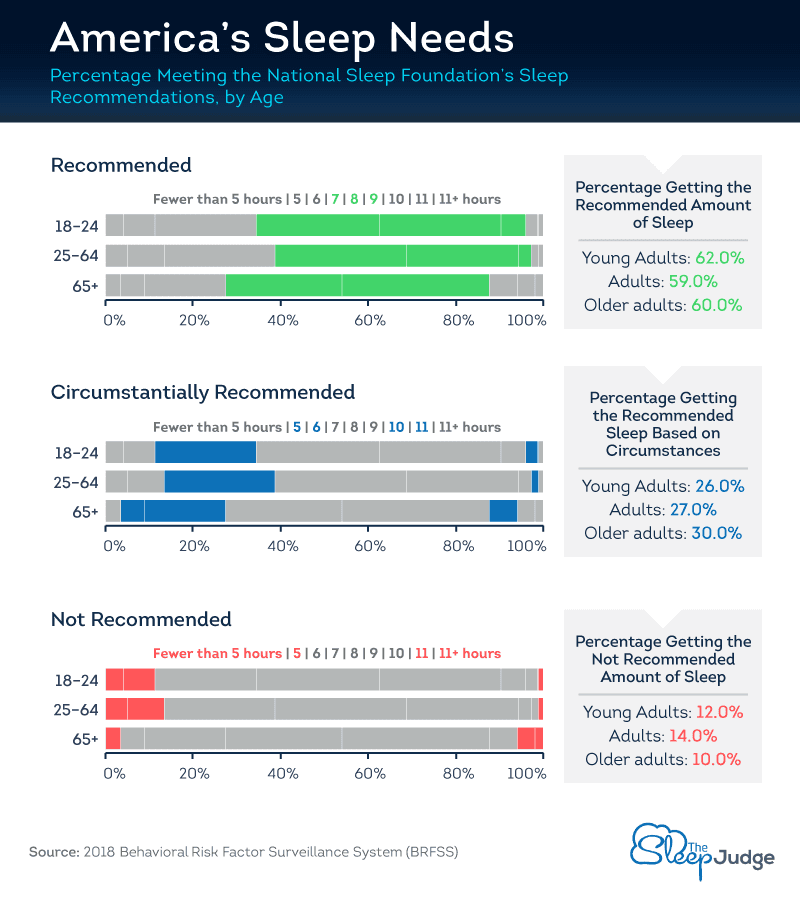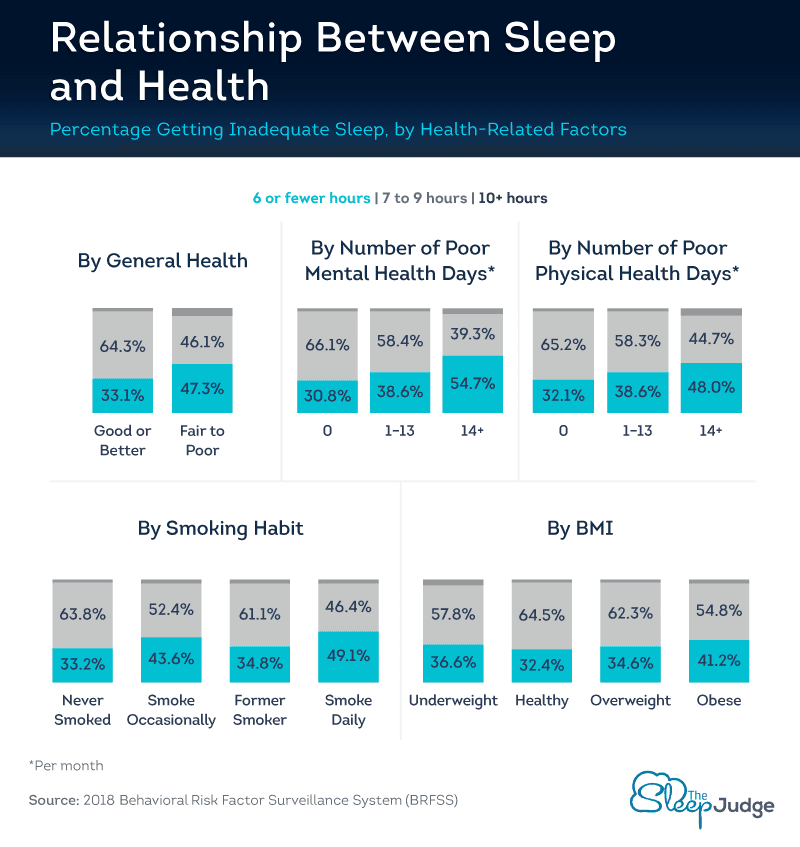Not every American may be getting their rightful share of restful sleep. With sleep connected to seemingly every aspect of mental and physical health, we had to know more about why our country might be so poorly rested.
First, we dove into the Centers for Disease Control and Prevention’s (CDC) Behavioral Risk Factor Surveillance System (BRFSS), which is the single largest continuously conducted health survey system in the world. Each year, the BRFSS collects more than 400,000 adult interviews regarding health-related risk behaviors. With this data, we uncovered not only which states suffer the most from poor sleep, but the possible reasons why. Read on to learn why your state, health habits, and relationship might prevent you from getting the sleep you need.
Sleep by State
Although the National Sleep Foundation recommends seven to nine hours of sleep each night for everyone aged 18 to 64, 35.7% of Americans still got six or fewer hours of rest on a nightly basis, which constitutes “inadequate sleep.” And some state residents were more likely to get inadequate sleep than others.
Despite being home to the “city that never sleeps,” New York was actually more rested than six other states: Hawaii, West Virginia, Kentucky, Tennessee, Michigan, and Ohio. The No. 1 state for inadequate rest, though? Hawaii. Nearly 43% of Hawaii residents reported inadequate sleep regularly. Studies show that locations with higher humidity (like Hawaii) may make your nights a little more restless. This may also explain other sleepless states on the map, like Louisiana, Florida, and Georgia.
h2, h3 {padding-top: 15px;
padding-bottom:5px;
}
Age of Rest?
Sleep patterns have been shown to change with age, so we made sure to look into which age groups achieved recommended sleep. It turns out that 62% of young adults got the recommended hours of sleep every night, although adults and older adults weren’t too far behind.
Sleeping for five to six or 10 to 11 hours may not be ideal, but it can be appropriate depending on the specific person, according to the National Sleep Foundation. Older adults were the most likely to fall into this circumstantially recommended sleeping category, with 30% of this age group clocking in somewhere between five and six or 10 and 11 hours of sleep each night.
What the National Sleep Foundation explicitly considers “not recommended” would be a night’s sleep for five or fewer hours and 11 hours or more. Adults were the most likely to fall into this sleeping category. Young and older adults were actually less likely to avoid this pitfall. Perhaps adults’ struggle with sleep is due to the majority of life’s responsibilities falling into the adult stages of life, as opposed to early life or older years.
Restless Life Stages
A person’s relationship status, income, and employment can impact many aspects of life, and sleep is no exception. Of these three things, however, employment impacted sleep the most intensely. Those who were unable to work were much more likely than all other employment types to get inadequate sleep each night.

Relationship status also had a heavy influence on sleep, more so than income. The highest prevalence of inadequate sleep existed among those separated or divorced, while those who were widowed or married slept most substantially. Divorce is often considered one of the top 10 most stressful life events, so mental woes may again be at play in keeping people awake.
Data also once again proved the adage that money can’t buy happiness. Income actually had a relatively small impact on a person’s ability to sleep well. About a thirdof those who earned $75,000 or more each year still got six hours or fewer of sleep each night. The percentages of those suffering from inadequate sleep did slightly increase as respondents earned less, but the impact was smaller than relationship status and employment status.
Habitual Sleep Habits
Both mental and physical health can hinder or help a person’s ability to sleep well. Specifically, the BRFSS revealed that those experiencing 14 or more poor mental health days within a year received inadequate sleep 54.7% of the time.
In fact, poor mental health made people even less likely to get a good night’s rest than physical health. Forty-eight percent of people with 14 or more poor physical health days got six or fewer hours of sleep each night.
Smoking habits were also often to the detriment of a good night’s rest, along with many other health risks. Those who smoked daily were the least likely to receive adequate sleep, followed by those who smoked occasionally and finally, those who formerly or never smoked. In other words, the less a person smoked, the more they slept. This is just another reason to put down the cigarette and prioritize good health.
Sleepless in the States
Health and sleep have an interesting relationship. Good sleep helps to create good health, while good health contributes to good sleep. The BRFSS confirmed exactly that but may not have necessarily left us with the tools to create healthy sleep routines.
Once you understand how important sleep is, the next step is to educate yourself on how to sleep better as well as find the perfect mattress for your needs. Fortunately, The Sleep Judge takes care of both of these things. Read through the countless reviews on everything from mattresses to pillows and box springs so that you are well-informed before making any important sleep purchases. Visit us today.
Methodology and Limitations
For this project, we evaluated 2018 data from the CDC’s Behavioral Risk Factor Surveillance System (BRFSS). It is published annually and presents data about the health and health care habits of the American population. We focused on questions about sleep quality and compared them to other health-related and demographic questions included in the survey. The BRFSS data use an internal weight, which we applied to the data shown in this project.
BRFSS data include data for all U.S. states. We excluded U.S. territories from our analysis. No statistical testing was performed.
Fair Use Statement
Do our findings about sleep and health in America interest you? The graphics and information found on this website are available for noncommercial reuse. Feel free to share them as much as you’d like across the web and on social media, but please make sure to link back to this page. Thank you!



